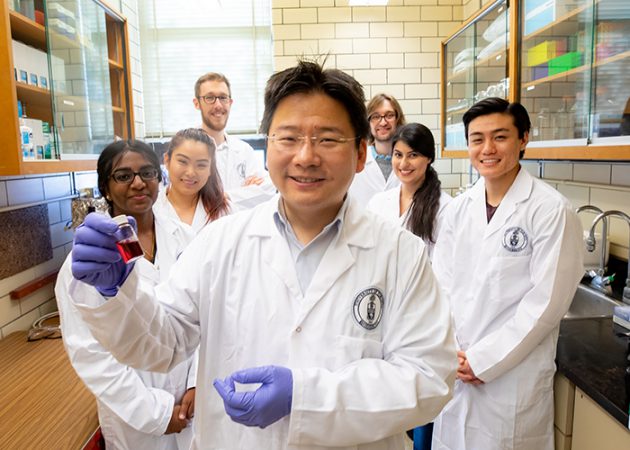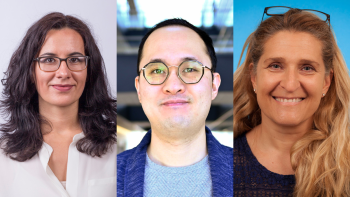Professor Frank Gu (ChemE) can sum up his team’s leading-edge research in four words: big challenges, tiny tools.
Gu and his team use nanoparticles — engineered materials measuring around one billionth of a metre — to address challenges in medicine, such as diagnosing infectious diseases and treating chronic eye conditions.
After joining U of T Engineering in July 2018, Gu was recently appointed the NSERC Senior Industrial Research Chair (IRC) in Nanotechnology Engineering. The new collaboration will apply cutting-edge nanotechnology to the next generation of medical devices and techniques.
“Nanotechnology has tremendous potential to advance medicine, particularly in the fields we focus on, such as biosensing and drug delivery,” says Gu. “This new program will foster fundamental discoveries, benefitting the biomedical community and the public, while translating knowledge from the lab to the Canadian industry.”
The ratio between one nanometre and the thickness of a human hair is about the same as one inch compared to a mile. At this scale, engineered structures have unique physical and chemical properties. Gu and his team leverage these properties to detect disease-causing organisms or target the action of drugs to specific organs.
Gu and his team have developed a “chemical nose,” a modified set of gold nanoparticles that interact with bacteria that cause disease. When mixed together in solution, the reaction causes a colour change, a rapid visual signal that indicates the present of pathogenic organisms. Such a test could be packaged into simple, low-cost kits that could be used to diagnose diseases in places where medical labs are hard to access.
The team has also done extensive work on using engineered nanostructures to deliver therapeutics to the human eye. These nanoparticle carriers slowly release therapeutic compounds over several days, reducing the number of eye drops that patients with chronic eye conditions — such as glaucoma or allergy — need to take.
“If you can treat for a week with just one dose, it means you don’t have to remember to take your drops every day,” says Gu. “That can really help with drug compliance, especially among people with cognitive impairments.”
The NSERC IRC program provides funding over five years to support academic-industry collaborations on both fundamental and applied research that is of commercial interest. With Gu’s appointment, U of T Engineering now boasts 11 IRCs, with collaborations in areas ranging from sustainability in the pulp and paper industry, to new techniques in drinking-water treatment.
“This partnership will strengthen Canada’s position as an international leader in nanomaterials and nanomedicine,” says Gu. “The path to commercialization is built in, so it won’t be long before these new technologies start making a difference in patient’s lives. That’s what I’m most excited about.”



